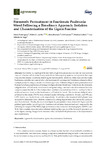Formosolv Pretreatment to Fractionate Paulownia Wood Following a Biorefinery Approach: Isolation and Characterization of the Lignin Fraction

Use this link to cite
http://hdl.handle.net/2183/26349Collections
- Investigación (FCIE) [1228]
Metadata
Show full item recordTitle
Formosolv Pretreatment to Fractionate Paulownia Wood Following a Biorefinery Approach: Isolation and Characterization of the Lignin FractionAuthor(s)
Date
2020-08-17Citation
Domínguez, E.; del Río, P.G.; Romaní, A.; Garrote, G.; Gullón, P.; de Vega, A. Formosolv Pretreatment to Fractionate Paulownia Wood Following a Biorefinery Approach: Isolation and Characterization of the Lignin Fraction. Agronomy 2020, 10, 1205.
Abstract
[Abstract] Paulownia is a rapid-growth tree with a high biomass production rate per year and low demand of water, which make it very suitable for intercropping systems, as it protects the crops from adverse climatic conditions, benefiting the harvest yields. Moreover, these characteristics make Paulownia a suitable raw material able to be fractionated in an integrated biorefinery scheme to obtain multiple products using a cascade conversion approach. Different delignification pretreatments of biomass have been purposed as a first stage of a lignocellulosic biorefinery. In this study, the formosolv delignification of Paulownia wood was investigated using a second order face-centered factorial design to assess the effects of the independent variables (concentrations of formic and hydrochloric acids and reaction time) on the fractionation of Paulownia wood. The maximum delignification achieved in this study (78.5%) was obtained under following conditions: 60 min, and 95% and 0.05% formic and hydrochloric acid, respectively. In addition, the remained solid phases were analyzed to determine their cellulose content and cooking liquors were also chemically analyzed and characterized. Finally, the recovered lignin by precipitation from formosolv liquor and the pristine lignin (milled wood lignin) in Paulownia wood were characterized and compared by the following techniques FTIR, NMR, high-performance size-exclusion chromatography (HPSEC) and TGA. This complete characterization allowed verifying the capacity of the formosolv process to act on the lignin, causing changes in its structure, which included both phenomena of depolymerization and condensation.
Keywords
Organosolv
Fractionation
Lignin
Characterization
Paulownia
Fractionation
Lignin
Characterization
Paulownia
Editor version
Rights
Atribución 4.0 España
ISSN
2073-4395






